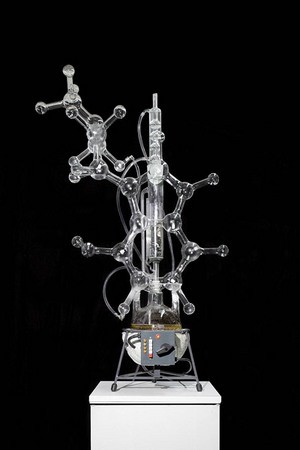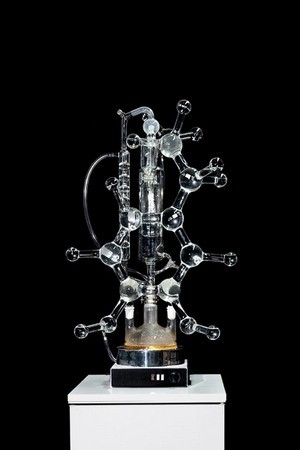Thomas Feuerstein
Psychoprosa
07 Mar - 10 May 2015

Thomas Feuerstein, Mr. P. / Mrs. D., 2014, Courtesy Galerie Elisabeth & Klaus Thoman Innsbruck/Wien, (c) 2015 Bildrecht, Wien
THOMAS FEUERSTEIN
Psychoprosa
7 March – 10 May 2015
In his exhibition PSYCHOPROSA, Austrian artist Thomas Feuerstein (*1968 in Innsbruck, lives in Vienna) employs biochemical processes as a means of artistic expression and creates an installation at the interface of art and a natural scientific experimental set-up. He transforms the rooms of the Galerie im Taxispalais into a coherent ensemble of greenhouse, laboratory, cooling chamber and factory. Linked by pipes, the apparatuses and objects seem like active protagonists: inside glass sculptures, substances are transformed by invisible laboratory assistants, refrigerators open and close as if inspired by demons or ghosts, and transparent threads of slime drip from extensive, vitreous installations.
Thomas Feuerstein works using media such as sculpture and installation as well as graphic art, painting, photography and net art, creating multilayered references to biology, the philosophy of science, economics, and cultural history in the process. His artistic production is characterised by engagement with a wide spectrum of theories and their aesthetic assimilation. He uses natural scientific methods to interlock the factual and the fictive in his processual installations, deconstructing scientific explanatory models' claims to truth and prompting new contexts of meaning. Chemicalphysical processes become metaphors of social structures; ideas from classical philosophy combine with phenomena from today's highly technological world in the field of research DAIMONOLOGY, developed by Feuerstein.
The exhibition in the Galerie im Taxispalais links new works and some older pieces never exhibited in the Tyrol before in order to produce a very specific narrative. The installative works are supplemented by graphic art and an audio play, which open up additional space for interpretation. At the beginning we find a greenhouse in which algae and fungi are cultivated. These organic materials are pumped into glass sculptures, where a synthetic hallucinogen is generated through a chemical process: the resulting molecule is PSILAMIN, which has never occurred before in a natural context. The remaining biomass of the algae and funghi is a slimy material, which develops a viscous consistency after heating, cooling and mixing: thick threads and veils form a transparent, liquid sculpture. If we were to consume the ‛molecular sculpture’ PSILAMIN, solid objects would deliquesce and begin to flow in our perception. In this way the psychotropic effect of the hallucinogenic substance ‒ which the exhibition visitor does not experience but can only imagine ‒ is reflected in the exhibition as a real process. Crossing and confusing the borderlines between our inner and external worlds is a central aspect of Feuerstein's PSYCHOPROSA. The slime that permeates the entire exhibition in a real as well as a thematic sense refers, on the one hand, to horror fiction and one of its early masters, H. P. Lovecraft (1890–1937); on the other hand it highlights – as a social metaphor – questions regarding the definition of the individual and the dissolution of social boundaries.
In cooperation with the Frankfurter Kunstverein and the Kunstverein Heilbronn
Psychoprosa
7 March – 10 May 2015
In his exhibition PSYCHOPROSA, Austrian artist Thomas Feuerstein (*1968 in Innsbruck, lives in Vienna) employs biochemical processes as a means of artistic expression and creates an installation at the interface of art and a natural scientific experimental set-up. He transforms the rooms of the Galerie im Taxispalais into a coherent ensemble of greenhouse, laboratory, cooling chamber and factory. Linked by pipes, the apparatuses and objects seem like active protagonists: inside glass sculptures, substances are transformed by invisible laboratory assistants, refrigerators open and close as if inspired by demons or ghosts, and transparent threads of slime drip from extensive, vitreous installations.
Thomas Feuerstein works using media such as sculpture and installation as well as graphic art, painting, photography and net art, creating multilayered references to biology, the philosophy of science, economics, and cultural history in the process. His artistic production is characterised by engagement with a wide spectrum of theories and their aesthetic assimilation. He uses natural scientific methods to interlock the factual and the fictive in his processual installations, deconstructing scientific explanatory models' claims to truth and prompting new contexts of meaning. Chemicalphysical processes become metaphors of social structures; ideas from classical philosophy combine with phenomena from today's highly technological world in the field of research DAIMONOLOGY, developed by Feuerstein.
The exhibition in the Galerie im Taxispalais links new works and some older pieces never exhibited in the Tyrol before in order to produce a very specific narrative. The installative works are supplemented by graphic art and an audio play, which open up additional space for interpretation. At the beginning we find a greenhouse in which algae and fungi are cultivated. These organic materials are pumped into glass sculptures, where a synthetic hallucinogen is generated through a chemical process: the resulting molecule is PSILAMIN, which has never occurred before in a natural context. The remaining biomass of the algae and funghi is a slimy material, which develops a viscous consistency after heating, cooling and mixing: thick threads and veils form a transparent, liquid sculpture. If we were to consume the ‛molecular sculpture’ PSILAMIN, solid objects would deliquesce and begin to flow in our perception. In this way the psychotropic effect of the hallucinogenic substance ‒ which the exhibition visitor does not experience but can only imagine ‒ is reflected in the exhibition as a real process. Crossing and confusing the borderlines between our inner and external worlds is a central aspect of Feuerstein's PSYCHOPROSA. The slime that permeates the entire exhibition in a real as well as a thematic sense refers, on the one hand, to horror fiction and one of its early masters, H. P. Lovecraft (1890–1937); on the other hand it highlights – as a social metaphor – questions regarding the definition of the individual and the dissolution of social boundaries.
In cooperation with the Frankfurter Kunstverein and the Kunstverein Heilbronn

